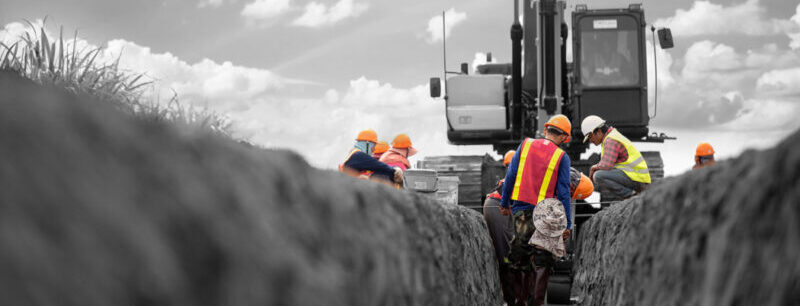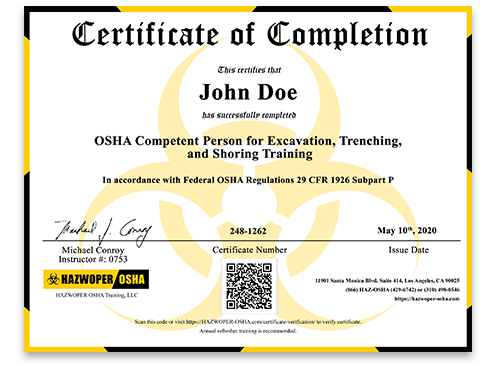
Trenching and Excavation Safety 1926 Subpart P
Excavation Safety Training for Competent Persons (6 Hours)
Our OSHA Competent Person For Excavation, Trenching, and Shoring Training course is designed for individuals seeking certification for trenching and excavation operations in compliance with OSHA regulations specified in 29 CFR 1926 Subpart P.
While excavating and trenching have a number of important applications (such as in mining, environmental restoration, and exploration), their use in the construction industry is one of the most common. These operations are used in the construction industry for pipe laying, building foundations, utility work, and more.
Working in and around trenching and excavation operations is inherently dangerous. Hazards include cave-ins, exposure to falling loads, electrocutions, oxygen deficiency, falls, and hazardous atmospheres (among many others). As part of a safety and health program, the OSHA excavations and trenching regulations specified in 29 CFR 1926 Subpart P require employers to implement specific practices that will help reduce the risk of on-the-job injuries and illnesses at trenching and excavation sites.
One of the safety practices required by OSHA is assigning a Competent Person to oversee operations at the excavation site. The Competent Person is responsible for classifying soil, inspecting protective systems, and monitoring the site for new or additional hazards. These roles make the Competent Person a crucial player in workplace safety. If your job requires you to work in and around excavations and trenches as a part of your job duties, then it is important that you receive additional on-site training from your employer in addition to this OSHA Competent Person for Excavation, Trenching, and Shoring Training course.
Course Objectives
After completion of the OSHA Competent Person for Excavation, Trenching, and Shoring Training course, the learner will be able to:
- Understand OSHA excavations and trenching regulations as defined in 29 CFR 1926 Subpart P and the safe work practices and procedures specified by this standard;
- List site conditions that must be evaluated before excavation operations begin;
- Distinguish between type A, B, and C soil;
- Explain what a competent person is responsible for in trenching and excavations operations;
- Explain what OSHA’s unconfined compressive strength measurement determines;
- Differentiate between the two basic methods used for soil classification: visual testing and manual testing;
- Understand the dynamics involved in a cave-in; and
- Explain OSHA regulations related to protective systems in excavated areas and the exceptions to these regulations.
Course Content
LESSONS
OSHA Competent Person for Excavation, Trenching, and Shoring Training: Introduction
- Lesson 1: Introduction to Excavations– Lesson 1 of the OSHA Competent Person for Excavation, Trenching, and Shoring Training course covers the following information:
- The definition of the terms excavation and trenching;
- Responsibilities of a Competent Person including soil classification, designing structural ramps, inspecting protective systems, monitoring water removal equipment, conducting site inspections, and more;
- How to access and egress from trenches or excavated sites;
- Types of site conditions to be examined before work begins such as overhead and underground utilities, emergency rescue equipment, stability of structures, and more; and
- The atmospheric testing procedures and ventilation required on a worksite.
- Lesson 2: Soil Classification– Lesson 2 of the OSHA Competent Person for Excavation, Trenching, and Shoring Training course covers the following information:
- The different types of soil (A, B, and C);
- Components of a visual test for soil classification;
- Three types of manual testing that can be done for classifying soil; and
- An explanation of OSHA’s unconfined compressive strength measurement.
- Lesson 3: Protective Systems– Lesson 3 of the OSHA Competent Person for Excavation, Trenching, and Shoring Training course covers the following information:
- OSHA regulations concerning protective systems;
- Discussion of the two general types of protective systems;
- The distinction between sloping and benching systems;
- The difference between shoring and shielding; and
- Options for shoring or shielding, including timber shoring, aluminum hydraulic shoring, trench boxes, or the use of a combination.
- Lesson 4: Requirements for Protective Systems– Lesson 4 of the OSHA Competent Person for Excavation, Trenching, and Shoring Training course covers the following information:
- Cave-ins, and how they typically occur;
- Factors to consider when designing protective systems, including when to hire a Registered Professional Engineer;
- OSHA requirements related to the installation and removal of protective systems; and
- Dewatering and water removal equipment.
- Lesson 5: Safe Work Practices– Lesson 5 of the OSHA Competent Person for Excavation, Trenching, and Shoring Training course covers the following information:
- Hazards associated with excavations and trenching operations, such as exposure to a hazardous atmosphere, exposure to falling loads, oxygen deficiency, and others;
- The importance of using proper protective systems and protective equipment on worksites;
- Safe work practices associated with excavations and trenching operations; and
- The conditions under which a Competent Person should inspect excavations and trenches.
Final Examination
This course has been created by OSHA-certified outreach trainers, and it is updated as OSHA releases new or modified requirements or regulations. This OSHA Competent Person for Excavation, Trenching, and Shoring Training course meets and exceeds compliance requirements as outlined in OSHA’s 29 CFR 1926 Subpart P standard.
Safety Training Certification
As soon as you pass the final exam, you will receive an emailed PDF of your course completion certificate for the OSHA Competent Person for Excavation, Trenching, and Shoring Training.

Training Requirements
There are no prerequisites for this OSHA Competent Person for Excavation, Trenching, and Shoring Training course.
A Final Note
It is important to remember that attending this OSHA Competent Person For Excavation, Trenching, and Shoring Training course will not make a worker competent. Competence develops over time by consistently implementing knowledge that’s been acquired through training courses like this one to various on-the-job work situations. Therefore, in addition to this online course, it is important that employees receive additional on-site training from employers.
Question: What is the duration of the OSHA Competent Person for Excavation, Trenching, and Shoring Training?
All our courses are designed to take a specific amount of time. However, some students may get through the course more quickly, while others may take longer to complete their training. This course will take around 2 hours to complete.
Question: What is the validity period of the OSHA Competent Person for Excavation, Trenching, and Shoring Training Certification?
OSHA does not specify how often someone needs to attend the competent person for excavation, trenching, and shoring training. However, OSHA does indicate that in order to perform the duties of a Competent Person, an individual must be trained and knowledgeable in the subjects of Soils, Protective Systems, and in the Requirements of the Excavation Standard. It is up to the employer to determine the employee’s capabilities and to designate trained and knowledgeable persons.
We are ‘recommending’ that employees undergo refresher training annually as regulations are frequently updated and in line with those changes our courses are also regularly updated. However, the final decision about the frequency of retraining rests with your employer.
Question: Who is a ‘Competent Person’?
- A competent person is an individual, designated by the employer, who is capable of identifying existing and predictable hazards in the surroundings or working conditions which are unsanitary, hazardous, or dangerous to workers, and who is authorized to take prompt corrective measures to eliminate them.
- Under the Excavation standards, tasks performed by the competent person include:
- Classifying soil;
- Inspecting protective systems;
- Designing structural ramps;
- Monitoring water removal equipment; and
- Conducting site inspections.
Question: Who should enroll for the OSHA Competent Person for Excavation, Trenching, and Shoring Training?
- Employees who work in and around excavations and trenches as they must be aware of measures to protect themselves from cave-ins, falling loads, electrocutions, explosions, falls, and hazardous atmospheres.
- Personnel designated by their employers as a ‘Competent Person’ would benefit from the OSHA Competent Person for Excavation, Trenching, and Shoring Training to meet the requirements of local, state, and Federal U.S. laws.
- Individuals who wish to refresh their knowledge and understanding on excavation and trenching operations and the responsibilities of a competent person, may also enroll for this safety training course.
Question: Which of the OSHA’s regulations is covered by the OSHA Competent Person for Excavation, Trenching and Shoring Training?
This course meets and exceeds the compliance requirements of OSHA’s Excavations Regulations as specified in 29 CFR 1926 Subpart P.
Question: What is the difference between and excavation and a trench?
OSHA defines an excavation as any man-made cut, cavity, trench, or depression in the Earth’s surface formed by earth removal. A trench is defined as a narrow excavation (in relation to its length) made below the surface of the ground. In general, the depth of a trench is greater than its width, but the width of a trench (measured at the bottom) is not greater than 15 feet (4.6 m).
OSHA Trenching and Excavation Fact Sheet